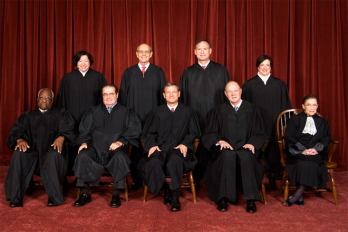TJSL Professors React to SCOTUS Ruling on Affordable Care Act
June 28, 2012
The U.S. Supreme Court’s 5-4 ruling on June 28 that largely upholds the Affordable Care Act of 2010 has TJSL professors expressing their views as they analyze the majority and dissenting opinions about the constitutionality of the highly controversial Obama administration health care reform law and the impact the ruling will have.
As the author of the majority opinion, conservative Chief Justice John Roberts surprised many Americans. “The Affordable Care Act’s requirement that certain individuals pay a financial penalty for not obtaining health insurance may reasonably be characterized as a tax,” Roberts wrote. “Because the Constitution permits such a tax, it is not our role to forbid it, or to pass upon its wisdom or fairness.”
TJSL Constitutional Law Professor Bryan Wildenthal says he always “thought it was virtually inarguable that the mandate was constitutional under clear existing precedent as a tax. Several precedents make clear that merely not calling it a ‘tax’ should not be decisive; nor does a tax have to have the primary goal of raising revenue, nor raise more than a minimal amount of revenue.
“The Court’s view that the health care law exceeded the commerce power is mere dicta without precedential effect, and unlikely to be given much weight by future Justices or majorities that might disagree with it. The commerce power issue was closer, but I think the Ginsburg quartet likely has the better argument there, too. But it’s a moot point for today.”
As for the Chief Justice being the pivotal vote, Professor Wildenthal says, “Roberts was aiming for the history books here. A possible parallel might be Chief Justice Charles Evans Hughes, a conservative Republican appointed by Hoover who eventually commanded 5-4 majorities to uphold key FDR New Deal legislation.
In agreement with the majority opinion, TJSL Professor Rodney Smith added, “Hooray for the principled commitment of Chief Justice Roberts. The tax power is the right place for this decision. In a world consumed by politics and ideology, Chief Justice Roberts has penned a principled decision, based appropriately on the taxing power. When Chief Justice Roberts was confirmed, President Obama and Vice President Biden were among 22 Senators who opposed his confirmation. This is further evidence that in a world dominated by political opportunism on all sides, the Court, under Chief Justice Roberts, charted a principled non-partisan course. When principle trumps momentary politics, we have reason to celebrate.”
TJSL Professor Steve Semeraro also gave a nod to Roberts: “This was a bold move. How many major decisions has a Chief Justice led a 5-4 majority against his own party since Earl Warren? I can’t think of a single one. Rehnquist’s decision in the Miranda case is the closest, maybe, but that wasn’t 5-4.”
While the majority opinion upheld almost all of the ACA, including the individual mandate requiring almost all Americans to obtain health insurance by 2014, the Court limited one major provision that would have allowed the federal government to cut off all of a state’s existing Medicaid funding if that state opted not to go along with the ACA’s expansion of Medicaid coverage. However, the majority upheld the Medicaid expansion as long as it remains optional for states to accept or not.
The Court’s restriction on the Medicaid expansion does not sit well with TJSL Professor Marjorie Cohn. “The Supreme Court upheld the individual mandate as a proper exercise of Congress’s power to levy taxes,” Professor Cohn noted. “This means that millions of uninsured Americans will now have health insurance and people cannot be denied coverage if they have pre-existing conditions. But seven justices voted not to require states to extend Medicaid to the poor. This is a blow to the millions of people who would have been eligible for Medicaid under the law that Congress enacted.”
View Professor Wildenthal’s commentary on the ruling on YouTube.
The SCOTUS opinions can be viewed at http://www.supremecourt.gov/opinions/11pdf/11-393c3a2.pdf
